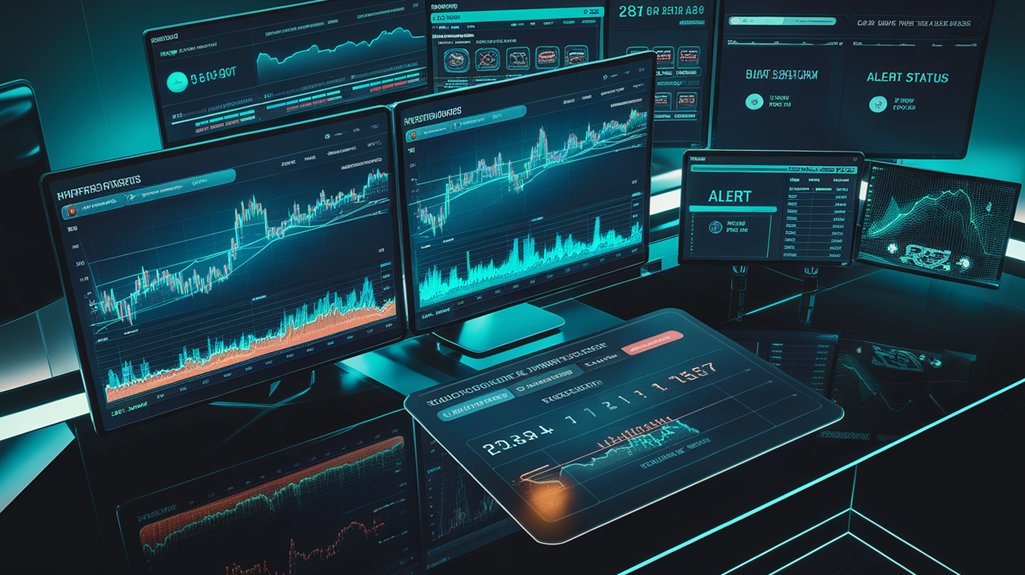Effective SAM notification monitoring systems require a multi-tiered framework with clearly defined alert levels. Organizations should implement performance-based threshold controls for key metrics like CPU utilization and memory usage, establishing both warning and critical parameters. Dependency mapping enables targeted alerts by visualizing relationships between infrastructure components, reducing alert fatigue through intelligent routing. Regular monitoring guarantees compliance with standards like NIST guidelines while maintaining operational efficiency. The modular entity hierarchy approach separates notification components for maximum flexibility across the enterprise.
Building Multi-Tiered Notification Frameworks

While implementing effective SAM notifications, organizations must establish a structured framework that manages alerts across multiple priority levels. This architecture typically consists of three distinct layers that optimize notification delivery across the enterprise. Regular progress monitoring helps quantify improvement and assess notification effectiveness across all tiers of the system.
The universal base layer handles standard communications through email, SMS, and push channels for all users. Above this, a targeted middle layer applies conditional message routing based on predefined rules, creating priority queues and department-specific channels. This approach aligns with MTSS framework that provides tailored levels of support addressing individual needs.
For critical situations, the intensive top layer triggers escalated notifications like manager alerts and system-wide broadcasts. Timely compliance alerts can prevent organizations from missing crucial government contract opportunities or important updates to registration status.
This tiered approach relies on a modular entity hierarchy that separates notification components into distinct tables: headers (SCC_NTFREQ_HDR), details (SCC_NTFREQ_DTL), and recipients (SCC_NTFREQ_RECP).
The separation enables flexible configuration while maintaining cross-tier compatibility, ensuring support flows seamlessly between layers without requiring redundant setups.
Implementing Performance-Based Threshold Controls

The framework architecture for SAM notifications sets the foundation, but organizations need specific triggers to activate this system effectively. Performance-based threshold controls provide these triggers by establishing specific markers that, when reached, initiate alerts and automated responses.
Effective threshold management begins with understanding key performance metrics such as CPU utilization, memory usage, and disk space availability. SolarWinds SAM offers both predefined thresholds for common statistics and options for customization based on organizational requirements. Typically, critical threshold levels for CPU usage should be set around 90% to balance between timely alerts and avoiding false positives.
IT teams can implement multi-level thresholds (warning and critical) to create graduated response systems. Thresholds can be seen through visual indicators where yellow represents warning conditions and red indicates critical thresholds have been reached.
Alert customization is essential for maintaining operational efficiency. By configuring alerts to trigger only when meaningful performance conditions occur, teams reduce alert fatigue while ensuring critical issues receive proper attention. Organizations should align these threshold controls with NIST guidelines to maintain compliance with federal cybersecurity policies when handling government contracts.
These customized alerts can initiate automated scripts that address issues without manual intervention, greatly reducing system downtime and enhancing overall performance monitoring capabilities.
Leveraging Dependency Maps for Targeted Alerts

Modern alerting systems become notably more powerful when integrated with extensive dependency mapping capabilities. Organizations can visualize relationships between infrastructure components, applications, and services to pinpoint precise alert scoping and reduce noise. Pattern-based mapping with detailed scripts provides accurate topology representation of complex systems, enabling more intelligent alert routing. Maintaining active SAM registration is crucial for entities seeking eligibility for federal contracts and grants.
Dependency visualization tools like Device42 automatically discover hidden connections between systems, creating accurate maps of both direct and transitive dependencies. Virima offers dynamic multi-layered mapping across on-premises, cloud, and hybrid environments to further enhance visibility.
Alert prioritization becomes more strategic when dependencies are properly mapped. Teams can:
- Focus first on business-critical application dependencies
- Group related configuration items to streamline triage efforts
- Identify bottlenecks and single points of failure
When integrated with ServiceNow’s CMDB, dependency maps highlight CI relationships during incident management, routing alerts to responsible teams based on mapped ownership boundaries.
Frequently Asked Questions
How Can I Reduce Alert Fatigue Among My IT Support Teams?
Organizations can reduce alert fatigue by implementing sound alert prioritization strategies that categorize notifications based on severity and impact.
IT teams should establish notification frequency adjustments to limit interruptions, consolidating non-critical alerts into scheduled digests.
Implementing AI-driven triage systems helps filter false positives while automating responses to routine issues.
Creating role-based alert routing guarantees notifications reach appropriate specialists, preventing unnecessary distractions for the entire team.
Regular alert audits can identify and eliminate redundant or low-value notifications.
Can SAM Alerts Integrate With Our Existing Ticketing System?
Yes, SolarWinds SAM alerts can integrate with existing ticketing systems through API support and webhooks.
This alert integration enables automatic ticket creation when monitors detect issues, eliminating manual processes. Organizations can configure bidirectional ticketing synchronization to update both systems simultaneously when changes occur.
The integration supports custom triggers based on severity levels and can follow established escalation policies. This streamlined workflow reduces response times and helps maintain consistent documentation of infrastructure issues.
How Should We Handle Alerts During Scheduled Maintenance Windows?
Effective alert management during maintenance windows requires suppressing non-critical notifications while maintaining visibility of essential system states.
Organizations should:
- Define recurring maintenance schedules in the monitoring system
- Configure alert suppression rules specific to maintenance timeframes
- Prioritize critical alerts while filtering routine notifications
- Test backup monitoring systems during planned outages
This approach prevents false alarms while ensuring true emergencies receive proper attention, supporting efficient maintenance scheduling.
What’s the Optimal Alert Retention Period for Compliance Requirements?
The ideal alert retention period varies based on applicable compliance regulations. Organizations should maintain alerts for at least 90 days for standard IT operations, but extend retention to three years for FLSA-related data and five years for SOX audit information.
HIPAA requirements vary by document type and should be evaluated individually.
Companies should consider both regulatory requirements and system performance limitations when establishing alert retention policies to guarantee compliance without compromising operational efficiency.
Can Custom Scripts Trigger Notifications Based on Application Log Contents?
Yes, custom scripts can effectively trigger notifications based on application log contents.
These scripts can be configured to scan logs for specific patterns, error messages, or threshold violations, activating notification triggers when predetermined conditions are met.
Platforms like ServiceNow, Google Apps Script, and Zoho support this functionality through built-in scripting environments.
Organizations can implement these solutions to alert administrators about critical events, security incidents, or performance issues captured in log content without requiring constant manual monitoring.